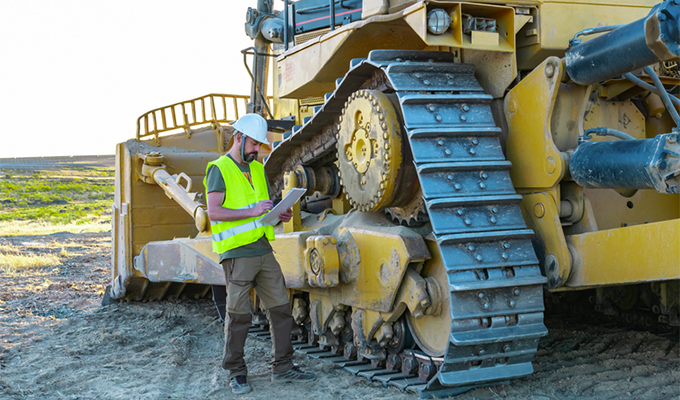Equipment inspection is pivotal in improving construction operations in several crucial ways. Inspections let you act proactively, identifying potential issues before they escalate into costly problems. This preventive approach significantly reduces downtime and maintenance costs.
Equipment Inspections
Equipment inspections let you systematically assess the condition of machinery to identify potential issues and ensure optimal performance. Here’s a simplified breakdown:
- Preparation: Gather necessary tools and documentation, including manuals and previous inspection reports.
- Visual inspection: Examine the equipment for visible wear, damage or leaks. This includes checking hoses, belts, and structural components.
- Functional testing: Operate the equipment to ensure all functions work correctly. This step helps identify issues that may not be apparent during a visual inspection.
- Checklists and standards: Follow industry-specific checklists and standards to ensure a thorough examination. This could include safety checks, fluid levels, and adherence to manufacturer recommendations.
- Documentation: Record findings and any necessary corrective actions. This documentation is crucial for tracking equipment history and planning future maintenance.
- Preventive maintenance: Based on inspection results, schedule preventive maintenance to address identified issues before they escalate. This proactive approach minimizes downtime and reduces overall maintenance costs.
Benefits of Equipment Inspections
The benefits of equipment inspections in improving construction operations are multifaceted, contributing to enhanced efficiency, cost-effectiveness, and overall project success. Here are some of the key advantages:
- Reduced maintenance cost: Regular inspections let you promptly identify and resolve minor issues, preventing them from evolving into costly repairs. This proactive approach leads to a significant reduction in overall maintenance costs over the equipment’s life span.
- Extended equipment life span: You can prolong the lifespan of construction equipment through inspections coupled with preventive maintenance. By addressing wear and tear in a timely manner, construction professionals ensure machinery remains operational and reliable for an extended period.
- Optimized operational efficiency: With equipment functioning at peak performance, construction operations experience enhanced efficiency. This optimization translates to smoother workflows, meeting project timelines, and maintaining a steady pace of progress.
- Client satisfaction: Meeting project deadlines and delivering consistent quality are crucial. Equipment inspections are pivotal in achieving these objectives by preventing unexpected setbacks and ensuring projects progress smoothly.
- Compliance with industry standards: Regular equipment inspections help construction teams comply with industry standards and regulations. This adherence ensures operations’ safety and positions construction professionals as industry leaders committed to best practices.
Utilization of Advanced Tools
One crucial aspect of equipment inspection is the utilization of advanced tools. Here are some examples:
Borescope: These cutting-edge devices allow construction professionals to delve into the intricate components of machinery, identifying potential issues that might go unnoticed in a cursory examination. They use high-resolution cameras and flexible tubing to provide a visual gateway into areas that would otherwise be inaccessible during a cursory examination.
This level of access is particularly crucial in identifying potential issues hidden within the machinery’s internal mechanisms. From inspecting intricate wiring to scrutinizing the condition of hard-to-reach components, borescopes offer a comprehensive view that adds depth to the inspection process.
Vibration Analysis Tools: These tools detect abnormal vibrations in machinery, providing insight into potential imbalances, misalignments, or structural issues. By analyzing vibrations, construction professionals can pinpoint areas that require attention before problems escalate.
Infrared Thermography Devices: Infrared cameras capture thermal images to reveal temperature variations in equipment. This technology is instrumental in identifying overheating components, electrical issues or insulation gaps that may lead to inefficiency or malfunctions.
Winter Hazards: Winter brings a unique set of challenges for heavy equipment operators, amplifying the importance of specialized inspection tailored to seasonal nuances. The harsh conditions demand a heightened focus on winter-specific inspection tips to fortify equipment against the elements.
These specialized inspections encompass a spectrum of considerations, from ensuring proper tire traction in icy conditions to examining hydraulic systems’ resilience in colder temperatures. Implementing winter-specific protocols safeguards personnel’s well-being and protects the machinery from potential damage caused by the unforgiving cold and moisture.
The Construction Landscape
Incorporating the insights you gather from inspections into your construction practices minimizes the risk of unexpected breakdowns.
Ultimately, the commitment to regular equipment inspections fosters collaboration among construction professionals. Architects, managers, and equipment operators all benefit from a
shared dedication to prioritizing inspections.
This collective effort contributes to enhanced project efficiency, client satisfaction, and the overall success of the construction industry.
About the Author
Jane Marsh is an environmental and green technology writer who covers topics in sustainable construction and green building materials. She also works as the editor-in-chief of Environment.co.


